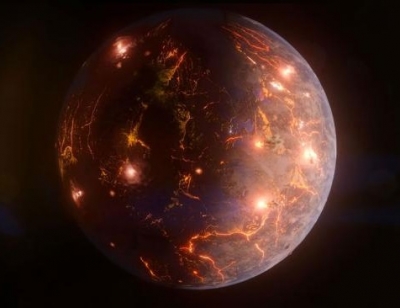Astronomers discover potentially volcano-covered Earth-size exoplanet

Washington, May 18: A team of astronomers have discovered an Earth-size exoplanet, or world beyond our solar system, that may be carpeted with volcanoes and is about 90 light-years away.
Called LP 791-18 d, the planet could undergo volcanic outbursts as often as Jupiter’s moon Io, the most volcanically active body in our solar system.
The exoplanet was found using data from NASA’s TESS (Transiting Exoplanet Survey Satellite) and retired Spitzer Space Telescope, as well as a suite of ground-based observatories.
The findings have been detailed in the scientific journal Nature.
“LP 791-18 d is tidally locked, which means the same side constantly faces its star,” said Bjorn Benneke, astronomy professor at Trottier Institute for Research on Exoplanets (iREx) based at the University of Montreal in Canada.
“The day side would probably be too hot for liquid water to exist on the surface. But the amount of volcanic activity we suspect occurs all over the planet could sustain an atmosphere, which may allow water to condense on the night side,” he added.
LP 791-18 d orbits a small red dwarf star about 90 light years away in the southern constellation Crater. The team estimates it’s only slightly larger and more massive than Earth.
Astronomers already knew about two other worlds in the system before this discovery, called LP 791-18 b and c.
The inner planet b is about 20 per cent bigger than Earth. The outer planet c is about 2.5 times Earth’s size and more than seven times its mass.
During each orbit, planets d and c pass very close to each other. Each close pass by the more massive planet c produces a gravitational tug on planet d, making its orbit somewhat elliptical.
On this elliptical path, planet d is slightly deformed every time it goes around the star.
These deformations can create enough internal friction to substantially heat the planet’s interior and produce volcanic activity at its surface.
Jupiter and some of its moons affect Io in a similar way.
Planet d sits on the inner edge of the habitable zone, the traditional range of distances from a star where scientists hypothesise liquid water could exist on a planet’s surface.
If the planet is as geologically active as the research team suspects, it could maintain an atmosphere. Temperatures could drop enough on the planet’s night side for water to condense on the surface.
Planet c has already been approved for observing time on the James Webb Space Telescope, and the team thinks planet d is also an exceptional candidate for atmospheric studies by the mission.






